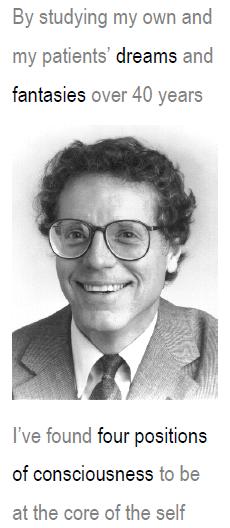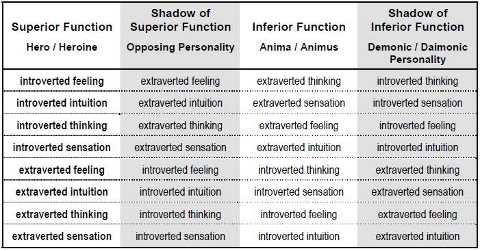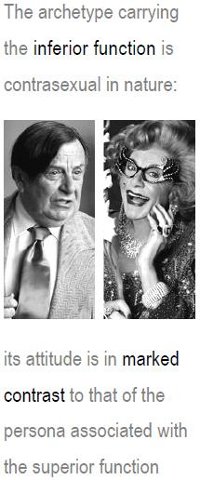
John Beebe 'Type and archetype'
Part 1: The spine and its shadow
The idea that each of us has the potential to access the full range of consciousnesses that Jung identified in Psychological Types is an appealing one, and one which, thanks in part to my own work, has been increasingly explored and accepted by a number of type practitioners in recent years.
Known as the eight-function model, the theory does not deny that each of us has just one superior and one auxiliary function on which most of us rely heavily; but it goes further, analysing how our consciousness operates when we find that we must reach beyond these two favoured ways of coming up with intelligent responses to life’s demands.
The eight-function, eight-archetype model of psychological types is based on two observations that are fundamental to its understanding and application.
The first observation is that in the course of our lives, we each actually make use of all the function-attitudes, those eight options of consciousness that Jung originally described in Psychological Types: introverted thinking, introverted feeling, introverted sensation, introverted intuition, extraverted thinking, extraverted feeling, extraverted sensation, and extraverted intuition.
The second observation is that these function-attitudes, though having typical characteristics that 86 years of type research have repeatedly verified, are not expressed in the same way by every individual who deploys them. There is a normal variation, not only in the strength and reliability of the functions, according to the degree of preference and practice that the individual will bring to the expression of each type of consciousness, but also in the role the individual enters when expressing a particular consciousness.
This second observation moves type theory well beyond Jung’s original discovery — clarified and amplified by Isabel Briggs Myers through her seminal insights into the nature of type development — that the function-attitudes arrange themselves as a series of numbered positions, implying a hierarchy of differentiation: i.e. dominant function, auxiliary function, tertiary function, and inferior function.
My own addition to type theory was to recognise that such a numbering of functions implies that there are, rooted in the structure of the psyche, eight positions, one for each function-attitude. This insight led me to postulate archetypal qualities adhering to each of the positions, rather in the way a local genius is said to preside over every town and city in Italy.
Here is a diagram that shows the archetypes that preside over the expression of the first four function-attitudes, in function positions from superior to inferior.
Figure 1: Archetypes associated with the first four function-attitudes (ENTP example)

The diagram shows these relations for a person whose MBTI type is ENTP, but the archetypes associated with the different numbered positions would be the same for the other 15 types as well, even though the function attitudes occupying the four positions vary according to the type.
Within this article I will be concentrating on the pair of archetypes associated with the superior and inferior functions in this diagram, which define an axis (the vertical line in the diagram) that I call the spine of personality, and adding to them two archetypes (not shown in this diagram) of the function positions that form the normally invisible shadow to this spine. (Archetypes associated with the auxiliary and tertiary functions, which form the arms of the diagram, and with their shadows, will be discussed in part 2 of this article.)
The function positions I am concentrating on here (the superior and inferior functions and their opposite-attitude shadows), together with their associated archetypes, form the core of any personality, which structures how the person’s consciousness is most characteristically used, for better and worse.
Most people who explore type start by locating their superior and inferior functions and develop a sense of how differently competent they feel when using one versus the other. They find it much more difficult to recognise when they are using these same functions with the opposite attitudes, however; for then, whether they realise it or not, they are drawing upon archetypes that serve not to realise the aims of the personality, but to defend it, usually by managing other people in oppositional and underhanded ways.
Before we can explore the archetypal characteristics of this core axis of the shadow, and of the spine of greater integrity that it shadows, we have to get better acquainted with how an archetype, a figure of the unconscious, can be associated with a function of consciousness, which seems to many people like a paradox. Let me trace my own history of developing this idea.
Early in my analytic training, I heard from older analysts, who seemed to have heard it from their analysts and supervisors — many close associates of Jung — if not from Jung himself, that the ‘inferior function’ is often associated with the archetype of soul in a man, and spirit in a woman.
For a man, it was said, the inferior function was carried by the Anima, the internal feminine figure that represents the instinct for soulful connection and reflection. In a woman, the inferior function was said to be carried by the Animus, the internal, masculine psychic figure that represents spirited standards.
My teachers’ expression ‘carried by’, I came to understand as ‘personified by’, ‘embodied by’, or ‘in the charge of’. This association of the inferior function with a contrasexual figure in the unconscious was implicitly contrasted by my Jungian teachers with the ego control that appears in relation to the ‘superior function’.
 My primary contribution to the deeper understanding of Jung’s typology was to ask, and to try to answer, the question: ‘If the functions in these two positions — inferior and superior — are tied, as they seem to be, to specific archetypes within the psyche, to what archetypes are the functions in the other positions linked?’
My primary contribution to the deeper understanding of Jung’s typology was to ask, and to try to answer, the question: ‘If the functions in these two positions — inferior and superior — are tied, as they seem to be, to specific archetypes within the psyche, to what archetypes are the functions in the other positions linked?’
By studying my own dreams, fantasies and behaviours, and those of my patients over 40 years of practising individual psychotherapy, and by using the films of visionary directors as a projection of the psyche, I have identified what seem to me to be convincing and reliable patterns of association. From these studies, I have found four positions of consciousness to be at the core of the individual self:
- the superior function
- the inferior function
- the shadow of the superior function
- the shadow of the inferior function.
By ‘shadow’, a term Jung deliberately left imprecise, I mean having the same function but the opposite attitude. So, for example, when the superior function is introverted feeling, its shadow is extraverted feeling, the inferior function is extraverted thinking, and the shadow of the inferior function is introverted thinking.
The table opposite shows these relations for all the different types of superior function, as well as the archetypes associated with the different type positions involved.(These latter links will be explained later in this article.)
Table 1: The superior and inferior functions and their associated archetypes

The superior function, not surprisingly, is the part of the ego we are most ready to claim ownership of, because it is associated with a sense of competence and potential mastery. The archetype that grants us this confidence in relation to the superior function (around which it is possible to develop a superiority complex) I have named the Hero in a man and the Heroine in a woman. This is a part of the psyche that welcomes facing challenges, that takes pleasure in recalling its past successful exploits, that revels in its unflagging reliability.
The differentiation of the Hero / Heroine is usually the work of childhood, and the more the original family recognises and values the superior function, the more the child is seen (at least in this area) as remarkable, competent, and gifted.
The inferior function, in contrast, is a perpetual source of shame for most people. Acknowledging and accepting this shame with a measure of humility is a first, necessary step towards knowing oneself, finding integrity, and beginning to make a meaningful connection to the unconscious.
 But because the inferior function is usually so poorly developed, especially in a young person, to be forced to use it can be an agony, and even calls forth a yelp of complaint, a cry that is often high-pitched in a man, full-throated in a woman. This sonic quality gives us a glimpse into the contrasexual nature of the archetype carrying the inferior function: the defensive, hysterical, helpless, irritated, bird-like whining in a man is the voice of the Anima under pressure, while in a woman the growl of an animal cornered, embittered and at the end of its rope, can emerge from the pressed Animus.
But because the inferior function is usually so poorly developed, especially in a young person, to be forced to use it can be an agony, and even calls forth a yelp of complaint, a cry that is often high-pitched in a man, full-throated in a woman. This sonic quality gives us a glimpse into the contrasexual nature of the archetype carrying the inferior function: the defensive, hysterical, helpless, irritated, bird-like whining in a man is the voice of the Anima under pressure, while in a woman the growl of an animal cornered, embittered and at the end of its rope, can emerge from the pressed Animus.
Despite its burden of shame, the inferior function, with its connection to soul or spirit, is also a place of great idealism in the psyche. The higher cause or mission that seizes our energy is often associated with this area of the psyche where we are ourselves rather weak and inept.
Thus, a person whose superior function is introverted thinking will often put a very high value on the goal of everyone in a group getting along together, although this person may lack any of the feeling skills to facilitate such an outcome. Conversely, an introverted feeling type may be drawn to champion the most abstruse strains of philosophy, even as he or she has to struggle to follow the more intricate twists of thinking.
The person who cares most passionately about the quality and safety of food may have superior introverted intuition and thus inferior extraverted sensation, while the person with superior introverted sensation may be the most concerned to maintain the quality of the future, for instance by acting now to reduce global warming, an extraverted intuitive precaution.
In Jungian psychology, Anima and Animus development are seen as the work of the second half of life, and the inferior function that is associated with Anima and Animus will start to appear in a much more creative and adapted way.
Sigmund Freud, whom Jung regarded as an introverted feeling type, developed the psychoanalytic theory after the age of 40. It was originally a sexual theory, in which the Anima value of connection was made biologically explicit. Freud even gave each of his closest supporters in Vienna a ring to wear, signifying their pledge never to be untrue to the sexual theory, at a time when Jung was already starting to deviate from this dogmatism. The analogy would be to Arthur’s knights swearing fealty to Guinevere.
The Jungian analyst Jane Wheelwright, an introverted sensation type by her own admission, began after the age of 50 to develop her creative Animus as a writer, addressing among other things how to counteract the fears of women as they grow older and exploring the possibilities of psychological development even in the face of death. Wheelwright’s writings at this stage of her life, reflecting her own Animus development, had a strongly extraverted intuitive cast.
When there is development of both the superior and the inferior functions, we can speak of a ‘spine’ of consciousness that gives a personality backbone. (In Freud’s case, the introverted feeling that made him a sensitive psychotherapist when that was still a very new medical subspecialty was combined with an extraverted thinking ability to clearly articulate a theory that made sense of the dynamics of the cases he treated.)
We know that the person’s consciousness is organised around a core of identity and integrity and that it stands for something. On the other hand, such a well-differentiated consciousness will also cast a definite shadow. The ‘spine’ of personality and its shadow for an introverted feeling man is shown in Figure 2.
Figure 2: The ‘spine’ of personality and its shadow (for an introverted feeling man)
Applying this model to the analysis of Freud’s consciousness, about which there is a considerable literature, since his standpoint has been so influential in the development of depth psychology generally, we are led to examine how he seems to have used his extraverted feeling and introverted thinking. It has been frequently documented how fraught with accusations of disloyalty, and examples of unrecognised unfaithfulness on his own part, Freud’s relations with colleagues were.
Recently it has come out that Freud was involved in a shadowy liaison with his sister-in-law, who lived with Freud and his wife. (Freud had begun ‘living in abstinence’ with his wife when he was 37, as she did not want to have another child.) The evidence that has surfaced of this longrumoured affair (which the sister-in-law may have confessed to Jung) is a hotel registration which indicates that the two registered as husband and wife when travelling together. All this suggests shadow extraverted feeling.
What is the evidence for shadow introverted thinking? Introverted thinking involves naming things in fresh ways, in relation less to outer definitions already agreed upon than to an archetypal sense of the things’ unconscious resonance. A non-shadowy introverted thinking can often find just the right name for something, but a shadowy introverted thinking may choose a name that gives the thing named a disagreeable association.
Thus Freud named the normal attachment that little boys have for their mothers the ‘Oedipus’ complex, and the normal interest we all have in our own self-image, ‘Narcissism’. But Oedipus actually slept with (and even married) his mother, and had to blind himself for the transgression of looking at her naked. And Narcissus fell in love with his image in a river and drowned trying to kiss it.
Such archetypal names for normal processes of development seem to me misnomers that undermine our sense of the necessity of such processes for normal development. In fact, they slowed down psychology’s sense of the role of attraction to the parent of the opposite sex in the course of developing a well-functioning sexuality, as well as the role of self-esteem in enabling any personality to flower. For generations, analysts warned their patients off interest in their parents and in themselves as signs of psychopathology, when they were not. This was the shadow that qualified the enormous therapeutic possibilities of the new discipline of psychoanalysis.
Today, we can speak of the archetypes involved in the way Freud used extraverted feeling (the shadow of his superior function) and introverted thinking (the shadow of his inferior function). I have named them the Opposing Personality (the archetype that led Freud to regard former colleagues such as Adler and Jung as ‘enemies’), and the Demonic Personality (the archetype that led him to distort and undermine the meaning of such universal aspects of child development as sexual interest in a parent, or intense fascination with oneself, that his scientific genius allowed him to discover in the fantasies and dreams of his patients — who assuredly were not dreaming of Oedipus and Narcissus).
I have found that the archetype I’ve named the Opposing Personality normally shapes the expression of its associated function-attitude in paranoid, avoidant, passive-aggressive and seductive ways. For the introverted feeling Freud, this was how his extraverted feeling tended to manifest, and a similar fate awaits each of us in the function-attitude that is the shadow of our superior one.
The Opposing Personality is a primary resource of defence, a part of us that tends to lurch forward first when we feel our heroic superior function and its most cherished values to be under attack.
We may also find ourselves thrown into the Opposing Personality when we are called upon to use the function-attitude that it carries. Thus, in writing about archetypes, which live most fully in the realm of introverted intuition, I, a person whose superior function is extraverted intuition, may find myself (as in this essay) using somewhat negative, oppositional examples, as above in my Jungian reading of Freud.
The archetype I have chosen to call the Demonic Personality shapes the expression of the function-attitude that shadows the Anima or Animus. We get a good image of the qualities of the Demonic Personality in the way Freud used language that twisted, in a pathologising direction, our whole culture’s understanding of some normal aspects of unconscious personality development, such that it has been the devil’s own work to rescue these areas of ourselves from the tendency within depth psychology to think about them negatively.
Yet it would be ungrateful to Freud not to admit that he also uncovered the areas of infantile sexuality and basic self-esteem that no psychologist before him had explored nearly so accurately. For that reason I often use the term Demonic / Daimonic Personality to convey that the archetype associated with the most unconscious of regions of the mind can deliver insights that are of the highest value, as well as depreciating and undermining ones. It is truly an area of ourselves that is both Devil and Angel.
The Demonic Personality is usually the focus of our most unyielding and unconscious flaws of character. When we act beastly, it is often through this archetype and its associated function-attitude.
I have interpreted the fairy tale Beauty and the Beast as a story of the struggle we all have with the worst part of our character. Beauty is the Anima, carrying the idealistic inferior function, with its burning concern for connecting in a quality way with others.
Beast is the Demonic/Daimonic Personality which in life, unlike the Beast at the end of most versions of the fairy tale, does not transform into a handsome prince. This most incorrigible of our function-attitudes stays a beast, but one that to some extent can be tamed through the Anima’s solicitous and energetic care.
Although we commonly feel excruciatingly self-conscious about the inferior function (the Anima and Animus can amplify that self-consciousness to the point of projecting that everyone is noticing our clumsiness in this area), it is important to realise that most of us are quite unconscious of the impact on other people of the functions carried by the opposing or demonic personality.
These less-inhibited parts of our functioning are among those that others experience negatively. They form the realistic basis of the ‘unfair’ judgments we sometimes experience ourselves receiving from others. It would be wiser for someone receiving such a judgment to say to him or herself, ‘That person has seen my shadow’.
The question for the development of consciousness is, can we learn to see it, too?
****
Copyright John Beebe MD, 337 Spruce St, San Francisco, CA 94118, USA. Permission granted for publication in the Australian Psychological Type Review.
This article was first published in TypeFace, the quarterly magazine of the British Association for Psychological Type (Autumn 2007, 18:2, 8-12), and is reproduced here by kind permission of the author and BAPT.


.jpg)

 (Opracowane na podstawie przedmowy Jerzego Prokopiuka do pracy: "Odpowiedzi Hiobowi" Carla Gustava Junga, Wyd. "Ethos", Warszawa 1995)
(Opracowane na podstawie przedmowy Jerzego Prokopiuka do pracy: "Odpowiedzi Hiobowi" Carla Gustava Junga, Wyd. "Ethos", Warszawa 1995)